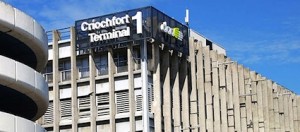Passenger growth at Dublin Airport will be stifled over the next five years unless the aviation regulator reverses its draft determination on airport charges, Dublin Airport Authority has warned. 
In a formal submission to the Commission for Aviation Regulation, DAA warns that traffic growth at Dublin Airport, which handles more than 80% of all international flights to and from the State, will be damaged by the regulator’s failure to allow essential investments aimed at improving facilities at Terminal 1, growing transfer passenger numbers, expanding the use of the main runway, and delivering additional aircraft parking areas.
The submission also points out that the regulator’s position on a number of these planned investments is directly contrary to the Government’s emerging National Aviation Policy, which supports the development of Dublin Airport as a secondary hub, and prioritises the delivery of new routes and services, particularly to new and emerging markets.
“Dublin Airport is currently enjoying strong passenger growth, which stimulates the Irish economy and helps grow inbound tourism,” said Kevin Toland, DAA Chief Executive. “But the aviation regulator’s short-sighted decision to veto key investments needed to allow Dublin Airport to win additional business will constrain passenger growth over the next five years and significantly impede the strategic development of the airport. The regulator has opted for stagnation at a time when we should be expanding rapidly.”
“The regulator’s draft determination also contains fundament errors that could affect safety and security at Dublin Airport. CAR’s stance on security staffing levels and essential investments in security screening procedures makes no sense. The regulator has vetoed mandatory investments in new security screening equipment needed to comply with new European regulations and has also refused to allow a number of airfield enhancements that will help improve safety.”
The Irish Aviation Authority, which is responsible for aviation security oversight within the State and is Dublin Airport’s safety regulator, has also raised significant concerns in relation to CAR’s proposals in a separate submission to the regulator.
Kevin described the regulator’s decision to ignore evolving Irish Government policy in relation to the aviation sector as inexplicable. “The Commission for Aviation Regulation had to be aware of the draft National Aviation Policy, which was published in May, and one must therefore ask why the regulator chose to ignore the broad Government policy priorities that are clearly set out in the document.”
DAA’s strategy is to maximise passenger growth opportunities at Dublin Airport over the next five years by keeping charges flat, offering generous incentives to airlines to increase their business and investing in key areas that will help deliver additional traffic growth and a better travel experience.
“Charges at Dublin Airport are already lower than the European average and the regulator’s suggested further reduction is both unwarranted and uneconomic,” he added. “Our policy of not increasing charges and prudently investing in incentives and improved infrastructure has delivered three and a half years of growth at Dublin Airport, but the regulator has opted to impede growth and provide a poorer product for passengers.”
In its draft determination on airport charges for 2015-2019, CAR has vetoed almost €170 million worth of essential upgrades – including projects specifically aimed at boosting passenger numbers and investments in new security measures that are required by law – and proposed lowering airport charges by an unsustainable 22% over the next five years.
CAR has blocked projects that would help deliver additional growth at Dublin Airport, such as an improved transfer facility to boost this fast-growing segment of Dublin Airport’s business, an upgrade to Terminal 1, which is now more than 40 years old, and airfield improvements to improve safety and allow increased use of the existing runway at busy times.
The regulator has also decided to delay the delivery of a new parallel runway at Dublin Airport beyond the next five years, leaving Ireland at a significant disadvantage to other western European countries that have runway capacity to accommodate new long-haul routes to the Far East. Currently, the construction of a second runway will be funded once passenger numbers reach 23.5 million – which will be in 2018/2019 according to CAR’s estimates. But the regulator has increased that threshold to 25 million passengers per year, pushing the delivery of a new runway into the next decade.
“Access to new and emerging markets in the Far East is vital for the Irish economy and for the tourism sector, but CAR mistakenly believes that it makes sense to postpone Ireland’s ability to offer direct connections to these vital locations,” said Kevin. “The foundation for the regulator’s financial calculations on operating costs is also flawed, as it is based on a scenario whereby Dublin Airport would operate with 100 fewer security staff while 580 other staff would be outsourced. But the regulator fails to explain how its forecast savings could be achieved, given prevailing Irish law in relation to the transfer of staff, or how Dublin Airport could continue to operate in those circumstances.
“The regulator has also ignored the wishes of Dublin Airport passengers, as upgrades to Terminal 1, which was built in the early 1970s, are strongly supported by passengers. A detailed study of T1 passengers found that not only did they support investments in improved facilities, but that they would be willing to pay for them through higher airport charges.
“The research showed that passengers rejected the option of lower airport charges, and said they would prefer to pay extra for improvements to the T1 arrivals area, the terminal’s facade, and check-in and security areas.
“The findings of the research couldn’t be clearer – passengers using T1 want a better product and are more than willing to pay for it. Our plan will deliver a significant improvements to Terminal 1 with no increase in Dublin Airport charges over the next five years.”
CAR issued its draft determination on Dublin Airport charges in May and is due to issue its final determination by the end of this month.




